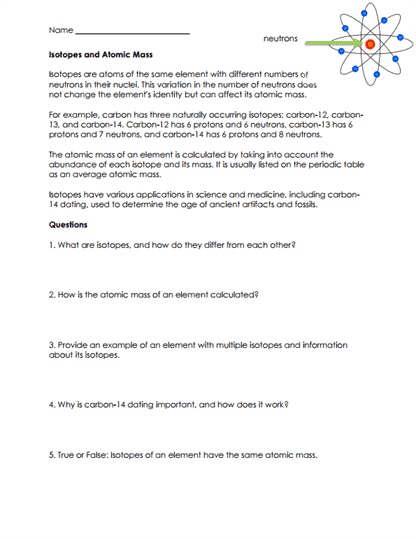Isotopes and Atomic Mass

Worksheet Description
The worksheet focuses on the concept of isotopes, which are atoms of the same element possessing different numbers of neutrons in their nucleus. By showcasing the carbon element as an illustrative example, the worksheet elucidates how isotopic variations do not alter elemental identity but can influence atomic mass. Additionally, the method to calculate the atomic mass of an element, taking into account the abundance of each isotope, is detailed. The worksheet culminates by highlighting the real-world significance of isotopes, particularly emphasizing the relevance of carbon-14 in dating ancient artifacts and fossils.
To adeptly tackle this worksheet, a student should commence by absorbing the fundamental definition and characteristics of isotopes. The visualization provided offers a tangible representation of the isotopic variations, aiding comprehension. As the student proceeds to the section detailing the calculation of atomic mass, careful attention to the integration of isotopic abundance with mass is crucial. Lastly, after gaining a foundational understanding of isotopes, students should attempt the accompanying questions, using the main content as a reference guide to construct well-informed answers.
This worksheet endeavors to introduce students to the intriguing world of isotopes and the intricacies of atomic mass. It aims to instill an understanding that while isotopes of an element have the same number of protons and thus the same elemental identity, variations in neutron count can lead to differences in atomic mass. Furthermore, the worksheet emphasizes the practical utility of isotopes, spotlighting their role in various scientific and medical applications. Through this nuanced exploration, students are poised to appreciate the depth of atomic structure and the profound implications isotopes have in diverse fields, from archaeology to medicine.
